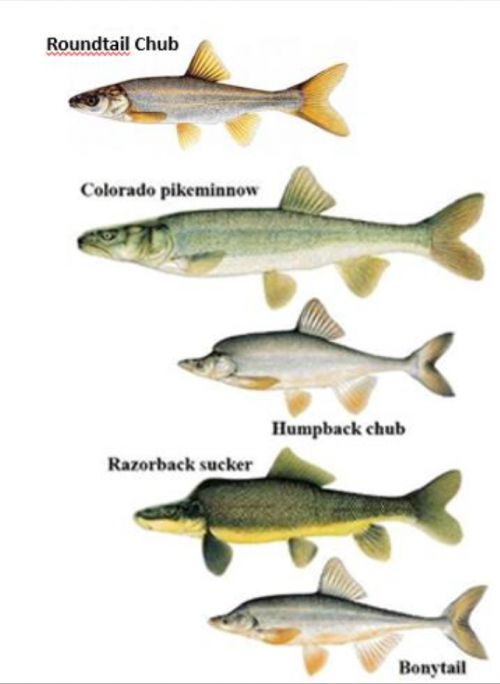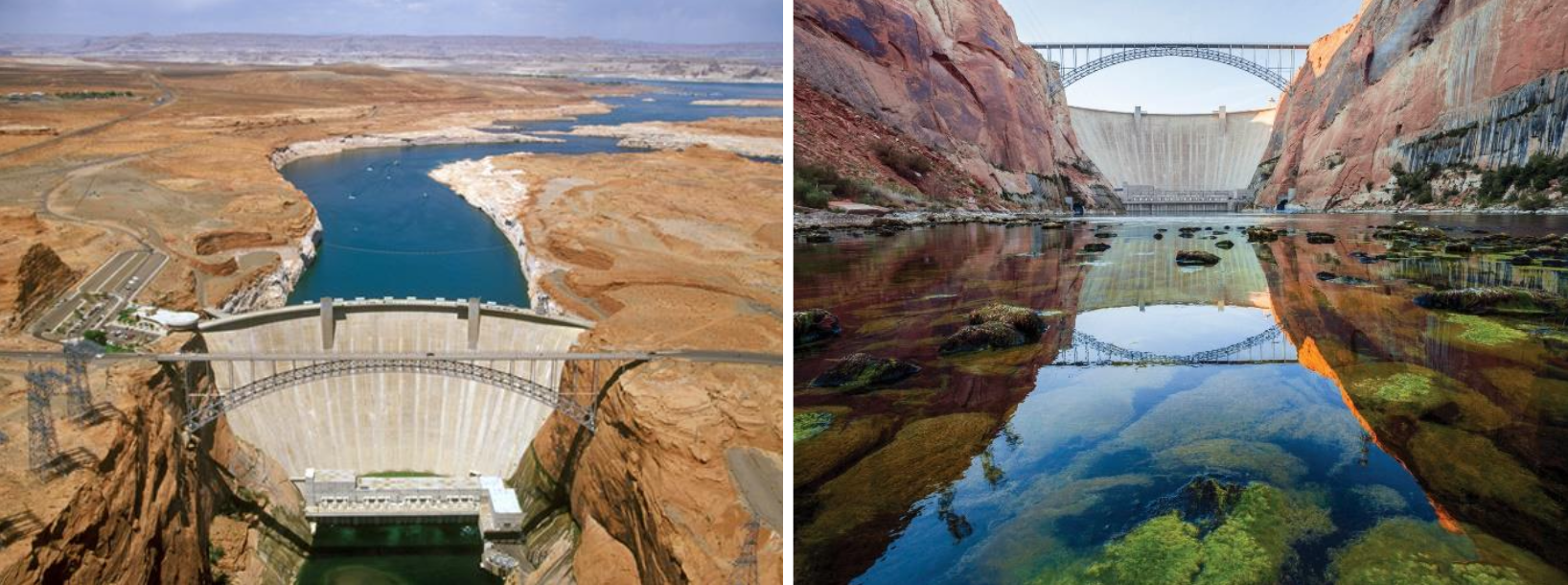The Colorado River, well known for cutting down through billions of years of geologic history to create the striking and unparalleled Grand Canyon, was once home to a great diversity of native flora and fauna. Like many large river systems around the world, the Colorado River Basin has undergone tremendous engineered change over the past century, as the American Southwest has grown crudely dependent on the river for its supply of water. 15 dams were built along the Colorado to allow for water storage, flood control and hydropower production. While these engineering feats have tamed the river to allow for the provision of water supply and hydropower to 7 surrounding states (Wyoming, Colorado, New Mexico, Utah, Nevada, Arizona, California) and Mexico1, not all river dependents have benefitted from these changes...
The Colorado River, well known for cutting down through billions of years of geologic history to create the striking and unparalleled Grand Canyon, was once home to a great diversity of native flora and fauna. Like many large river systems around the world, the Colorado River Basin has undergone tremendous engineered change over the past century, as the American Southwest has grown crudely dependent on the river for its supply of water. 15 dams were built along the Colorado to allow for water storage, flood control and hydropower production. While these engineering feats have tamed the river to allow for the provision of water supply and hydropower to 7 surrounding states (Wyoming, Colorado, New Mexico, Utah, Nevada, Arizona, California) and Mexico1, not all river dependents have benefitted from these changes. In particular, the river’s native fish populations have been severely hurt while trying to adapt to the rapid changes in the river system. UC Davis PhD student in ecology Mikaela Provost has taken a deeper dive to investigate how and why dams have impacted native fish populations2.
The 1,450 mile long river is unique for the large number of native fish species that are found nowhere else in the world. In 1895, before the construction of any dams and alteration of the river’s flow, two researchers from the US Bureau of Fisheries working on the river marveled at this phenomenon and claimed that over three quarters of the fish species in the river basin were “endemic” to the basin (i.e. found nowhere else), the largest proportion of endemism in a single river basin anywhere in North America3. The uniqueness of the species in the Colorado River is attributed to the long isolation of this river system from any other freshwater river systems, allowing significant time for new fish species to have evolved from those that had been found in other systems and were the colonizers of the Colorado. These unique species, however have been severely impacted by the development changes of the basin. According to Provost in fact, it can be argued that the Grand Canyon system has undergone one of the most complete collapses of native fish, more so than seen anywhere else in the U.S. Of the 8 native fish species found in the Grand Canyon National Park stretch of the Colorado, two (Humpback Chub and Razorback Sucker) are currently endangered, three (Colorado Pikeminnow, Roundtail Chub and Bonytail) have disappeared from the river system entirely, and three (Bluehead Sucker, Flannelmount Sucker, and Speckled Dace) are persisting. So what is causing these native population struggles? Provost suggests two likely threats- the dams and non-native species.

Native fish populations are widely understood to be vulnerable to river flow changes caused by damming. Dams trap sediment, preventing the material from moving downstream in the river channel and being deposited to build banks, sandbars, and pools off the main channel that form habitat that many fish species use for spawning, feeding, and protection. This is easily seen on the Colorado within Grand Canyon National Park, where Glen Canyon Dam (just upstream of the park) blocks 90% of the historic load of sediment from getting downstream. Along with this sediment comes detritus (i.e. decaying organic matter) which provides a nutritious food source for fish. But, low sediment means low food.
Beyond the loss of important habitat and food materials, the water releases from dams on the Colorado spill out from of the bottom of the reservoirs. This means the water released to the river is very cold year-round (average 46°F), with essentially no seasonal fluctuations, as had naturally occurred (oscillations between 0-80°F). Water temperature affects fish growth rates and the native fish species that were used to seasonal fluctuations were not equipped to live in the colder water year-round, growing and developing much slower than historic life cycles.

Thus, closely following early dam construction in the 1930s, native fish populations began to decline. Less than forty years later, the native fish species downstream of the Glen Canyon Dam had largely been replaced by exotic, non-native species. These non-native species, many intentionally introduced for fishing, have been largely out-competing native fish species for food and habitat. They do better growing in colder waters and aren’t dependent on seasonal floods and low flows for reproduction and juvenile growth.
Minimal remediation efforts have been attempted to reduce the negative impact of the dams on native fish populations. These efforts have been focused around a handful of occurrences of mimicking high historic flows through controlled flood releases. However, the few occurrences of these timed floods have resulted in little measured effect on the distribution, abundance, or movement of native fish species. Provost explains, “In a sense, we’ve stacked the deck against native fish species. Although, there are efforts to preserve those that are left, it’s unclear how effective it will be.” Stay tuned for continued discussions on alternative management plans that experiment with flow release rates, timing and temperature, in attempts to preserve these unique fish species of the Colorado.
References:
1 “Changing the Course: The Colorado River”. National Geographic Society. 13 February 2017. <national.geographic.org>
2 Provost, M. “Response of native and non-native fish to dams on the Lower Colorado River”. Presentation given to Grand Canyon 2017 class. University of California Davis. 8 February, 2017.
3 Evermann, B.W., and C. Rutter. 1895. The fishes of the Colorado Basin. Bulletin of the U.S. Fish Commission for 1894, 14:473-486.
